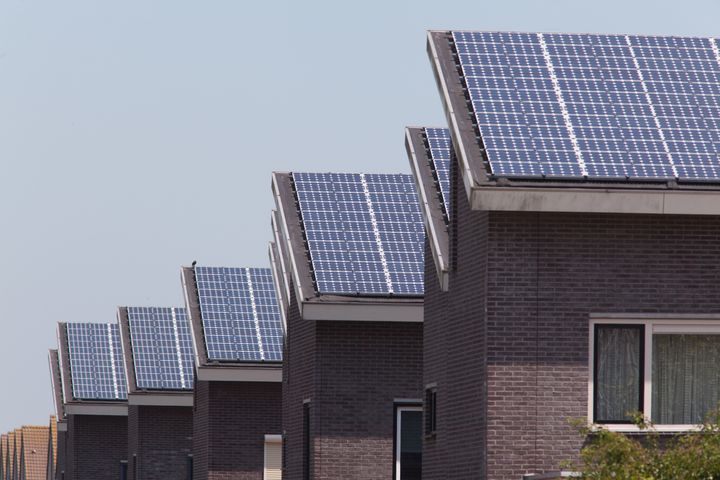
The electricity is coming back on in the wake of Superstorm Sandy and the people of New York and New Jersey are talking about how to rebuild, and how to make energy infrastructure changes to address a new stormy reality. The Dot Earth Blog, for example, is discussing small natural gas cogeneration plants that kept NYU powered up when lower Manhattan went dark. Others are talking about microgrids, smart planning and flood control systems.
Solar power must be in the mix. The region affected by Sandy has vast untapped potential to produce clean power and cut the carbon emissions that might be exacerbating these storms in the first place.
Let's just look at one county as an example. Hudson County, New Jersey sits just across the river from Manhattan and was hit hard by Sandy. The town of Hoboken was flooded and nearly all of the county's 641,000 inhabitants were without power for days. For all but the most aggressively mobile, long-term loss of power means no cell phone, no news, no essential plug-in medical devices, no fridge.
All of these people would benefit from solar power.
To be clear: during a major power outage, the most common types of rooftop solar power systems would not have you charging your cell phone or running a dialysis machine. Usually they're tied into the grid and are automatically disconnected when the grid is down. In order to be completely independent, you need a system configured to provide energy directly to your property, or you'd need a battery storage system. Because batteries are more expensive than generators, not a lot of folks buy them.
However, municipalities, neighborhood co-ops and commercial projects can change that. Communal storage solutions can be found. As Sandy demonstrated, even one building with power can be a support center for a whole neighborhood.
Geostellar ran some numbers on Hudson County, just to find out how much untapped potential is there.
We determined that 101,475 structures in Hudson County were well-suited for rooftop solar energy installations, looking at solar irradiance, the pitch of the roof, shading from trees and buildings, and other factors. Then we computed the amount of energy each of these sites would produce if a solar array was installed.
The result? By plastering every suitable rooftop with panels, our solar calculator says that Hudson County could be producing 2.42 terawatts of power annually. That's 2.42 million megawatts. That is huge potential! There are a lot of commercial buildings in Hudson County, with a lot of big flat roofs, so the average size of a system there would be big -- almost 17 kW. But let's be more realistic; let's say the county utilized just 10 percent of their capacity: that would still be 242 gigawatts of power per year.
That means Hudson County could have a storm-proof source of 27.6 megawatts of power every hour. That's enough to power 172,500 refrigerators, or 81,176 computers, or 460,000 incandescent 60-Watt light bulbs round the clock.
It's also enough to take a good piece of the load off the county's 1.1 gigawatt Hudson Generating Station in Jersey City, which runs two dirty fossil-fuel-burning units belching out carbon pollution.
In fact, developing 10 percent of the county's solar potential would avert the production of 170,594,310 pounds of CO2 every year, not to mention the mercury, arsenic and other toxins produced by the coal-fired Hudson unit. That's the equivalent of taking 15,173 passenger cars off the road or saving 767 acres of forest from deforestation. And that would not only make for cleaner air, but could reduce the likelihood of another Sandy.
That same 10 percent development could also save $39,241,524 in electricity bills, assuming a New Jersey average residential retail rate for electricity of 16.24 cents per kilowatt-hour.
Every move to make solar cheaper to install makes power cheaper and savings go up. Right now in New Jersey, policy is helping solar achieve what's called grid parity with conventional power (nuke, coal, gas): New Jersey's robust Solar Renewable Energy Credits (SREC) program, in which pollution-creating utilities pay the owner of a solar energy system for each megawatt of clean energy produced, brings down the cost and makes solar more feasible. As true grid parity is achieved, the use of solar is expected to skyrocket.
Bottom line? New Jersey residents would have more money to buy those battery storage systems. And that's just a start: many other counties in the state have even greater solar potential.
Solar energy has to be part of the plan when we talk about rebuilding in the wake of Sandy. We can make our neighborhoods more livable, no matter what the weather.
#
Dean Kuipers is Community and Content Director at Geostellar, an online solar energy resource and marketplace. A former editor at the L.A. Times, he is the author of "Operation Bite Back," "Burning Rainbow Farm," and other books. He lives in L.A.